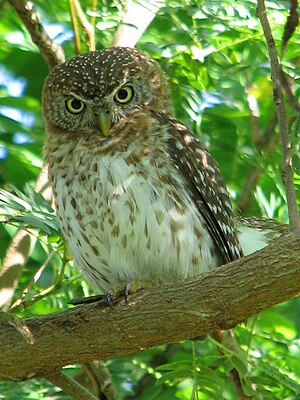Cuba pygmy owl
| Cuba pygmy owl | ||||||||||
|---|---|---|---|---|---|---|---|---|---|---|

Cuba pygmy owl ( Glaucidium siju ) |
||||||||||
| Systematics | ||||||||||
|
||||||||||
| Scientific name | ||||||||||
| Glaucidium siju | ||||||||||
| ( d'Orbigny , 1839) |
The Cuba pygmy owl ( Glaucidium siju ) is a small species of pygmy owl . The owl, which is barely the length of a hand, occurs in two subspecies exclusively in the Caribbean .
Appearance
The Cuba pygmy owl reaches a body size of about 17 centimeters. The head is rounded and feather ears are completely absent. The wax skin around the nostrils is a little less noticeable than is the case with other American pygmy owls. The eyebrows are whitish. The face veil shows indistinct concentric brown and whitish lines.
Like all other pygmy owls, the Cuba pygmy owl has an occipital face on its neck . The parting has pale small spots. The coat and the back are striated across. The front chest also has horizontal stripes. The flanks and the lower breast are brownish to ocher colored; however, a small region from the throat to the fore chest is devoid of darker markings. The tail has five to six pale horizontal stripes. The eyes are yellow.
No other pygmy owl species occurs in the distribution area of the Cuba pygmy owl. The Kuba Screech-Owl is slightly larger with a body length of 20 to 23 centimeters and has long, featherless legs and usually brown eyes. The rabbit owl is significantly larger than the Cuba pygmy owl.
Distribution area and habitat
The Cuba pygmy owl is endemic to the islands of Cuba and Isla de la Juventud . It is a resident bird that inhabits semi-open forests, forests in the coastal region, mountain forests, forest edges, plantations and larger parks with old trees and shrubland. The altitude distribution ranges from sea level to altitudes of around 1,500 meters above sea level.
Way of life
Similar to a number of other pygmy owls, the Cuba pygmy owl is partly diurnal. It is therefore more often hated by songbirds . Its food spectrum consists mainly of insects and small reptiles. Small mammals and birds make up a smaller proportion of its prey spectrum. He mainly acquires his prey by hunting from high hide.
Very little is known about the reproductive biology of this owl. It mainly uses old woodpecker holes as a nesting opportunity. The breeding season usually falls in the dry season. The clutch consists of three to four white eggs. The female breeds alone.
supporting documents
Single receipts
literature
- Claus König , Friedhelm Weick: Owls of the World . Christopher Helm, London 2008, ISBN 978-0-7136-6548-2
Web links
- Glaucidium siju inthe IUCN Red List of Threatened Species 2013.1. Listed by: BirdLife International, 2012. Retrieved October 9, 2013.
